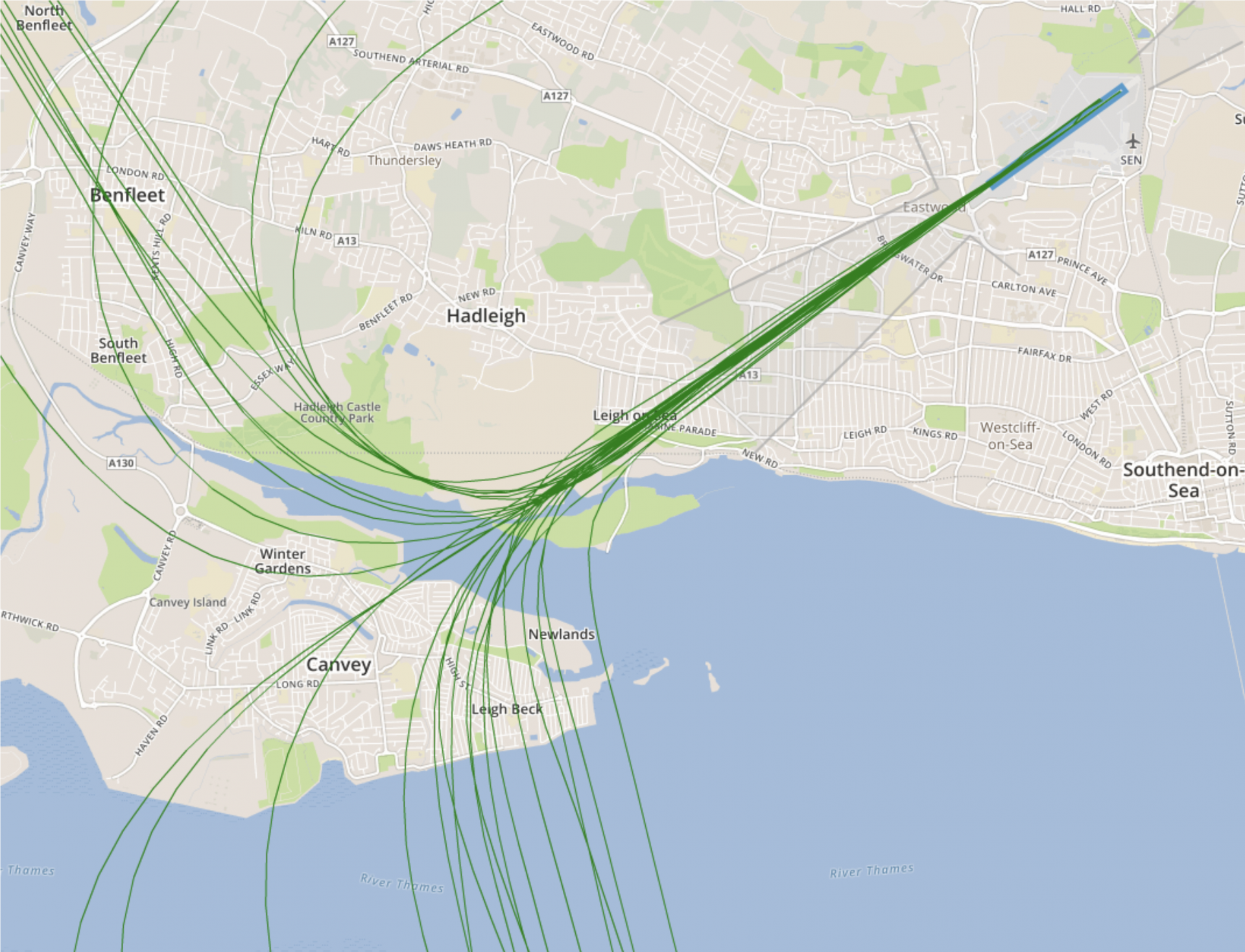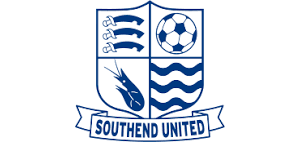Does anyone know, with a degree of certainty, when airlines are allowed to land and take off at Southend? I vaguely remember when Stobbards first started up that there were restrictions after a certain time at night and again first thing in the morning.
-
Welcome to the ShrimperZone forums.
You are currently viewing our boards as a guest which only gives you limited access.
Existing Users:.
Please log-in using your existing username and password. If you have any problems, please see below.
New Users:
Join our free community now and gain access to post topics, communicate privately with other members, respond to polls, upload content and access many other special features. Registration is fast, simple and free. Click here to join.
Fans from other clubs
We welcome and appreciate supporters from other clubs who wish to engage in sensible discussion. Please feel free to join as above but understand that this is a moderated site and those who cannot play nicely will be quickly removed.
Assistance Required
For help with the registration process or accessing your account, please send a note using the Contact us link in the footer, please include your account name. We can then provide you with a new password and verification to get you on the site.
You are using an out of date browser. It may not display this or other websites correctly.
You should upgrade or use an alternative browser.
You should upgrade or use an alternative browser.
Southend Airport
- Thread starter Yorkshire Blue
- Start date
Does anyone know, with a degree of certainty, when airlines are allowed to land and take off at Southend? I vaguely remember when Stobbards first started up that there were restrictions after a certain time at night and again first thing in the morning.
I was working there for a good year after Stobart took over and there wasn’t a restriction at all. We used to have the Bin Air freight aircraft land at all sorts of hours. It would sometimes land 2am get refuelled and then take off an hour or so later.
I would imagine midnight would be their limit on commercial aircraft. But they also take a lot of diverts in so there is probably no restriction.
Why what’s up?
Benfleet A1
Hector Of The House
Does anyone know, with a degree of certainty, when airlines are allowed to land and take off at Southend? I vaguely remember when Stobbards first started up that there were restrictions after a certain time at night and again first thing in the morning.
First flights are 6am not sure about the last ones, around 10ish?
I think I'm going to have to get off my lazy arse and actually ask the Airport. Certainly we are noticing flights coming in quite late now (after 11pm) and there is a regular flight out at 5 am. I posted earlier on another thread that EasyJet are far quieter than Ryan Air and Mad Cyril tells me that's down to the aircraft they use. Either way, since the arrival at the Irish the noise levels have risen considerably.First flights are 6am not sure about the last ones, around 10ish?
Does anyone know, with a degree of certainty, when airlines are allowed to land and take off at Southend? I vaguely remember when Stobbards first started up that there were restrictions after a certain time at night and again first thing in the morning.
This may help.
Everything you need to know
London Southend Airport said:Introduction
Causes of aircraft noise
The noise from a plane is caused by two things: by air going over its fuselage and wings (or ‘airframe’) and by the engines.
Airframe noise occurs when air passes over the plane’s body (the fuselage) and its wings. This causes friction and turbulence, which make a noise. Even gliders make a noise when in flight – and they have no engines at all. The amount of noise this creates can vary – according to the way the plane is flown – even for identical aircraft. Planes land with their flaps down which creates more friction (and produces more noise) than a plane with its flaps up
Engine noise is created by the sound from the moving parts of the engine, and also by the air being expelled at high speed once it has passed through the engine. Most of the engine noise comes from the exhaust or jet behind the engine as it mixes with the air around it.
Modern noise levels
Aircraft today are much quieter than they were 40, 30 or even 20 years ago. And these will be replaced by even quieter aircraft in the future. But, of course, even though each individual aircraft is quieter, there are more planes flying today. This means that the average level of noise is lower than before, but you may hear individual planes more often.
Brief History of Southend Airport
The airfield was first established over 100 years ago by the Royal Flying Corps during World War I. The airport was officially opened as a municipal airport in 1935. In 1939, the Air Ministry requisitioned the airfield and it was known as RAF Rochford during World War II when it became a base for fighter squadrons comprising Supermarine Spitfires and Hawker Hurricanes as well as Bristol Blenheims.
The number of flights and type of aircraft using London Southend Airport throughout its long history has varied greatly. In the 1960’s and 1970’s London Southend Airport was the third busiest airport in the UK, offering scheduled passenger flights to Europe using Carvair aircraft which passengers could drive their cars into, and in the 1980’s London Southend Airport was handling over 100,000 aircraft movements each year.
Whilst passenger services declined in the 1990’s the airport did remain a major hub for maintenance companies, with large aircraft – such as the B727 and BAC1-11 being regularly maintained at London Southend Airport.
In 1993, after the airport had been making losses for many years, Southend Borough Council sold the airport to Regional Airports Ltd (RAL), who set about turning the airport into a profitable business and got planning permission for a new rail station to be added to the London Liverpool Street line, which would enable future development of the site. In December 2008, the airport was sold to the Stobart Group who then sought planning permission to extend the usable runway length by 300m to 1,799m and upgrade navigational and lighting aids. Planning permission for the runway extension was granted 20 January 2010.
The runway extension, opened in 2012 allowed for the airport to increase the range of destinations offered beyond the scheduled passenger services to Ireland and the Channel Islands.
Operating Controls
As a result of planning permission being granted for the 300m runway extension in 2010, a Section 106 agreement was entered into between the airport and local councils. A number of new controls and incentives were agreed and introduced to help minimise any negative impact on the surrounding communities that the airport development might bring.
Operational Controls Summary Table
Download a summary of the operational controls which were agreed by Rochford District Council, Southend-on-Sea Borough Council and London Southend Airport. This is also available on the Southend-on-Sea Borough Council website.
Night Flights
Southend Airport has always been operational 24/7. As part of the S106 planning agreement (2010), the night period was extended from midnight – 06:00 to 23:00 – 06:30. As well as extending the night period, a number of tighter restrictions at night were implemented;
As has always been the case, freight, business, hospital, positioning and other types of flights can operate during the night. These flights are not listed on our arrivals and departure boards as they are not relative to passengers.
- The night quota was reduced from 940 to 120 night flights per month
- Private helicopters were banned at night
- Only aircraft with a noise QC level of 1 or less may operate at night* see below
- Passenger flights can only be scheduled between 06:30 to 23:30 (limited quota between 23:00 – 23:30) however delayed and diverted passenger flights may still operate.
Certified noise level (EPNdB) - Quota count
- During this night period only aircraft classified with a Quota Count of one (QC) or less are permitted to take-off or land. Aircraft are assigned quota count (QC) classifications as shown in the table below:
- 96 - 98.9 - QC/4
- 93 - 95.9 - QC/2
- 90 - 92.9 - QC/1
- 87 - 89.9 - QC/0.5
- 84 - 86.9 - QC/0.25
Aircraft classifications can be found on the NATs website.
Runway Direction
The direction that aircraft take off or land generally depends on the wind direction. For performance and safety reasons, aircraft will take off and land into wind. Due to prevailing south west winds, around 70% of aircraft movements arrive from the North East (over Burnham-on-Crouch/Rochford) and depart to the South West (over Leigh on Sea). When the wind is calm the direction of runway is determined by the wind direction at between 1000ft and 3000ft. On the unusual occasion that the wind is light and variable at 3000ft, several factors are taken into consideration when determining which runway direction to use, including the most appropriate approach routing for arrivals, the weather, and the current air traffic in airspace around the airport.
Preferred Runway Scheme
During the night period – when weather and safety conditions allow – London Southend Airport is committed to operate all aircraft movements from and to the north east (over Rochford) as this is a much less densely populated area than that to the south west of the airport.
During the daytime – when weather and safety conditions allow and movement volumes allow the runway direction to be changed – London Southend Airport agreed to ensure that more than 50% of aircraft operations occur to and from the north east of the airfield over Rochford.
The S106 planning agreement identifies a number of reasons whereby the preferred runway procedure may not be implemented:
The airport’s performance against this scheme is reported in Section 8 of its Annual Report.
- Safety
- Any reasonable requirements of the air traffic control of the airport to ensure the safe operation of the airport and aircraft using it
- Standard separation requirements of National Air Traffic Services
- Weather conditions prevailing at the time of the relevant air traffic movement (ATM) making it unsafe for an aircraft to take off to the north east of the airport or land from the north east of the airport
- Performance capabilities of the aircraft to take off from or land at the airport in the prevailing conditions at the time of the relevant ATM and/ or
- Limitations of the approach aid facilities at the airport
Noise Preferential Routes
To minimise the number of local residents being overflown by departing aircraft, noise preferential routes were introduced as a condition of the S106 planning agreement (2010). This means that all aircraft weighing over 5700kg must follow a straight departure heading for 2.5 nautical miles when departing towards the south west (over Leigh-on-Sea) and 1 nautical mile when departing towards the north east (over Rochford). This ensures that within the surrounding areas, departing passenger aircraft will only overfly those residents already living under the arrival path to the airport.
Once aircraft have cleared the designated NPR zone and reached a height of more than 1,500ft, Air Traffic Control (ATC) can instruct the pilots to fly a more direct heading towards their destination – this is known as ‘vectoring’. However, ATC may direct aircraft off the NPR at any time if this is required for safe separation from other aircraft or for other safety issues (such as avoiding adverse weather). Track keeping is taken very seriously and it is closely monitored and logged by our dedicated system.
The map below shows the two NPR zones at London Southend Airport and some typical departure tracks towards the North East (over Rochford) and the South West (over Leigh on Sea);

Weather and Aircraft Noise
One factor that does affect the way aircraft noise is perceived is the atmospheric conditions at the time of the flight. If we experience calm atmospheric conditions usually associated with warmer weather, sound waves will travel further and as such, it is perceived that the noise is greater. In more turbulent conditions associated with wind and rain, sound waves get dispersed and thus making aircraft appear quieter. It’s a similar scenario to dropping a pebble in a pond; the ripples travel further if the water is still. If you introduce waves, the ripples are dispersed more quickly so travel less distance.
Low clouds also have an insulating effect on aircraft noise. This is another reason why on a cloudless day, the noise seems greater.
During strong wind conditions, it has been shown that sound waves can be carried for large distances. This means that aircraft taxiing on the ground at Southend can be heard some distance away from the airport in a similar manner to road noise. During the night, when background noise is far lower, the sound of an aircraft taxiing may carry even further.
Noise Action Plan
In accordance with the terms of the Environmental Noise (England) Regulations 2006, Southend Airport submitted a revised Noise Action Plan to DEFRA on 29/11/18. A formal letter of Adoption was received 13/2/19. In line with DEFRA guidelines the revised adopted Noise Action Plan has been published on our website with 28 days of adoption.
You can download the Noise Action Plan here.
Aircraft activity to the North East (Rochford/Burnham-on-Crouch)
ARRIVALS on runway 23

There have not been any changes to the final approach flight path as a result of airport development or increased passenger fights.
Burnham on Crouch is located approx. 6.6 miles from the airport and sits directly under the extended runway centreline meaning that, when the wind is south westerly (approx. 70% of the time) arriving aircraft will overfly the town centre at a fairly consistent height of between approx. 1,800ft – 2,000ft, making use of the Instrument Landing System (ILS) which ensures a safe and accurate final approach at a fixed glide path of 3 degrees At this stage of the approach (approx. 5-8 miles out) the wing flaps may be adjusted and the landing gear will be lowered to help slow the descent, this will alter the air flow over the aircraft frame which can create variations in the level of aircraft noise.
Rochford is located directly North East of the runway and encompasses some of the airport boundary. Aircraft arriving on runway 23 will pass over Rochford as they make their way down to the runway.
DEPARTURES on runway 05

The only changes to the initial departure route in recent years has been to adopt a noise preferential route in accordance with our S106 planning agreement (2010). Aircraft departing on runway 05 towards the North East must maintain a straight departure heading for at least 1 mile and reach 1,500ft before they may turn. This reduces the number of residential properties overflown in Rochford.
Departing aircraft will gain lift as quickly as possible and will therefore always be higher than arriving aircraft in the same location. The tone of sound from a departing aircraft may however seem louder, depending on where you are in relation to the initial departure sequence, as the engines are working harder on departure than arrival.
When runway 05 is in use (winds are North Easterly) many of the aircraft will turn towards their destination before reaching Burnham on Crouch. Only aircraft that are vectored towards Clacton for European countries such as Holland, Germany, Belgium will overfly Burnham on Crouch, where they should be at a height of approx. 2,500ft - 3,000ft.
Aircraft activity to the South West (Leigh on Sea/Canvey Island)
ARRIVALS on runway 05

The only changes to the final approach path in recent years has been to increase the ILS fixed glide path to 3.5 degrees from 3 degrees. This increases the height of aircraft making an ILS approach, as they overfly Canvey Island and Leigh on Sea.
Canvey Island is located approx. 6 miles from the airport and sits directly under the extended runway centreline meaning that, when the wind is North Easterly (approx. 30% of the time) arriving aircraft will overfly the town centre at a fairly consistent height of between approx. 1,500ft – 1,800ft, making use of the Instrument Landing System (ILS) which ensures a safe and accurate final approach at a fixed glide path of 3.5 degrees. (The ILS is fixed slightly higher on runway 05).
At this stage of the approach (approx. 5-8 miles out) the wing flaps may be adjusted, and the landing gear will be lowered to help slow the descent, this will alter the air flow over the aircraft frame which can create variations in the level of aircraft noise. Leigh on Sea lies directly to the South West of the airport and sits directly under the extended runway centreline meaning that, when the wind is North Easterly (approx. 30% of the time) arriving aircraft will overfly the town at approx. 1,000ft from 3 miles out, and will continue to descend down to the runway.
DEPARTURES on runway 23

The only changes to the initial departure route in recent years has been to adopt a noise preferential route in accordance with our S106 planning agreement (2010). Aircraft departing on runway 23 towards the South West must maintain a straight departure heading for at least 2.5 miles and reach 1,500ft before they may turn. This reduces the number of residential properties overflown in Chalkwell, Eastwood, Westcliff and other residential areas to the north and south of the extended runway centreline.
Departing aircraft will gain lift as quickly as possible and will therefore always be higher than arriving aircraft in the same location. The tone of sound from a departing aircraft may however seem louder, depending on where you are in relation to the initial departure sequence, as the engines are working harder on departure than arrival.
When runway 23 is in use (winds are South Westerly) many of the aircraft will turn towards their destination before reaching Canvey Island town centre.
The precise height of departing aircraft over Leigh on Sea will vary according to your distance from the airport and extended runway centreline, aircraft type (performance capabilities), weight (including number of passengers) and weather conditions. All aircraft above 5700kg will be at a height of at least 1,500ft as they pass over Hadleigh Road (2.5 miles from the airport).
Approach Guidance Systems
ILS – Instrument Landing System
The ILS utilises three radio beams which are emitted from ground based infrastructure located within the airport boundary. One beam ensures that the aircraft is aligned with the runway centreline, one creates a “glide path” for aircraft to follow to allow them to descend at the correct speed and angle and one gives distance away from touch down. This system works in conjunction with specialist systems on board the aircraft and allows for a consistent flight path. The ILS approach is used for all arrivals during low visibility and low cloud and is classed as a precision approach.
Visual Approach
A visual approach is where pilots position the aircraft to land by using a visual reference to the airfield. The pilot will manually fly the aircraft and will align with the runway using a combination of visual referencing and various lighting systems that are on the ground at the airport. A visual approach can only be flown when visibility is good and when the clouds are above a certain height. The flight path over the ground for a visual approach can vary.
Noise Monitoring
The noise from planes is measured for many reasons. It is important to understand the impact on our local communities and to know whether the noise levels are increasing or decreasing over time.
In the UK, noise measurements are evaluated using the average noise level during the day (a 16-hour day) during the summer period. The measure of noise is given in decibels (dB). This averaged decibel measurement ‘LAeq’, is the most common international measure of aircraft noise, it means ‘equivalent continuous noise level’.
The latest noise contour maps are published in the Annual Report. The noise contours are reviewed every two years and all qualifying properties falling within the contours will be notified if they qualify for the Property Acquisition or Sound and Thermal Insulation Grant Scheme (see FAQs below for more information).
Thanks mate, that is exactly what I wanted to know. You are a veritable font of knowledge BD
The General
The Mouse (*)
I think I'm going to have to get of my lazy arse and actually ask the Airport. Certainly we are noticing flights coming in quite late now (after 11pm) and there is a regular flight out at 5 am. I posted earlier on another thread that EasyJet are far quieter than Ryan Air and Mad Cyril tells me that's down to the aircraft they use. Either way, since the arrival at the Irish the noise levels have risen considerably.
1st flight out is 630 and last one back in is 11pm from what I know. Planes can fly at night but these will be operational/positional reasons so that's why 1 may always take off at 5am!
I've always been an advocate of a successful airport and I still am, its good for the town, but the arrival of Ryan Air isn't filling my eardrums with much joy.
Mad Cyril
The Fresh Prince of Belfairs⭐⭐
I used to live in Rochford as a kid in the late 70s and 80s and heard large aircraft all hours day and night.Does anyone know, with a degree of certainty, when airlines are allowed to land and take off at Southend? I vaguely remember when Stobbards first started up that there were restrictions after a certain time at night and again first thing in the morning.
Stan33
Youth Team⭐⭐
- Joined
- Jul 18, 2015
- Messages
- 1,265
6-30 to 11Does anyone know, with a degree of certainty, when airlines are allowed to land and take off at Southend? I vaguely remember when Stobbards first started up that there were restrictions after a certain time at night and again first thing in the morning.
I was working there for a good year after Stobart took over and there wasn’t a restriction at all. We used to have the Bin Air freight aircraft land at all sorts of hours. It would sometimes land 2am get refuelled and then take off an hour or so later.
I would imagine midnight would be their limit on commercial aircraft. But they also take a lot of diverts in so there is probably no restriction.
Why what’s up?
Increasing flights late at night and very early morning. The noise levels have definitely been getting more noisy for longer.
Stan33
Youth Team⭐⭐
- Joined
- Jul 18, 2015
- Messages
- 1,265
As I understand it ,it's 6-30 'till 11 ,they do sometimes abuse 11 at night ,but u can set your clock by 6-30 take offIncreasing flights late at night and very early morning. The noise levels3030 have definitely been getting more noisy for longer.
OldBlueLady
Junior Blues Coordinator⭐⭐
The Carvairs used to rattle the windows at WHSG on take off when coming over the building back in the 70s, can't imagine the modern jet engines do that these days!
Ex-Member1
Full Back
- Joined
- Nov 24, 2007
- Messages
- 0
Living in Eastwood in the 1950s and 60s, the memories of the black and white TV picture fading and wobbling every time a Bristol Freighter flew over the house!
Stan33
Youth Team⭐⭐
- Joined
- Jul 18, 2015
- Messages
- 1,265
They start at 6-30 ,if u don't believe me u can come with your stop watch into my bedroom and listenThere’s usually 4-5 departures between 6.25am and 7.00am each morning and a couple of arrivals after 11.00pm. the last arrival tonight (from Malaga) is delayed and now due in at 1.18am.
Benfleet A1
Hector Of The House
They start at 6-30 ,if u don't believe me u can come with your stop watch into my bedroom and listen
Inviting complete strangers into your bedroom? Weido!! ?
Stan33
Youth Team⭐⭐
- Joined
- Jul 18, 2015
- Messages
- 1,265
Inviting complete strangers into your bedroom? Weido!! ?
I guessed some clever dick would respond in some way like that ,well done
They start at 6-30 ,if u don't believe me u can come with your stop watch into my bedroom and listen
Well, the first flight for today to Faro took off a few mins early at 6.23am and yesterday’s listings had 2 flights confirmed as departed at 6.25am. Stop watch is no good for telling the time...
ShrimperZone - Player Sponsorship










